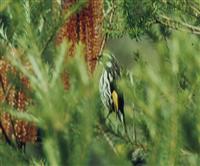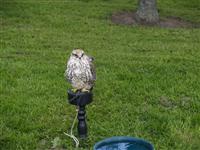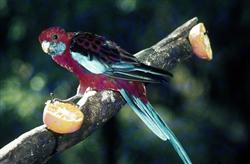Study the Science of Ornithology
Learn with us what is a bird, how they evolved, what adaptations they developed to be able to colonise air, land and water so successfully! This course is designed for people working or wishing to work with birds and animals, life scientists and environmental researchers and consultants, amateur bird watchers, or anyone working with birds. Learn to identify and understand the habits of different birds, from water birds and parrots, to town birds and birds of prey.
COURSE STRUCTURE
The course consists of nine lessons.
1. Classification and Introduction to Bird watching.
 Nature and scope of ornithology (over 9,000 species)
Nature and scope of ornithology (over 9,000 species)- Place of Birds in Nature
- Bird Classification (Aves, Ratitae, Carinate)
- Use of common names and scientific names
- Fossil or Extinct Birds
- Classes and Sub Classes
- Comparing characteristics of different Super orders
- Comparing characteristics of all major bird Families
- Resources for further information
- Bird Watching equipment
2. The Biology of Birds.
- Anatomical features
- Skeleton
- Feathers
- Feather Colour
- Wings
- Wing Types (elliptical, high speed, long soaring, high lift)
- Legs and Feet
- Beaks and Bills
- Internal Structure
- Respiration
- Excretion
- Digestion
- Circulation
- Senses
- Avian Behaviours (Flight, Diving, Reproduction, Courtship, Bonding, Territoriality, Nesting)
- Formation of Eggs and Hatching
- Feeding
- Vocalisations
- Migration
- Habitats
3. Common and Widespread Land Birds.
- Eagles and Relatives … Carthatidae (New World vultures, condors)
- Pandionidae (osprey)
- Accipitridae (hawks, eagles, kites)
- Sagittariidae (secretary bird)
- Falconidae (falcons, caracaras)
- Crows and their Relatives
- Butcher birds, Currawongs and related birds
- Pigeons (structure, feeding, breeding, types)
- Doves
- The Dodo
- Cuckoos
- Pest and Introduced Birds (for man countries) … Indian Mynah, Sparrow, Thrush, Starling, etc
4. Giant Birds and Long Legged Birds
- Ratitites …Ostrich, Emu, Moa, Rhea, Cassowary, Kiwi, South American Tinamous, extinct giant Elephant bird and Dodo
- Herons, Storks and relatives
5. Seabirds and Water birds.
- Anseriformes … ducks, geese, swans etc
- Gruiformes …cranes, coots, mud hens, rails
- Charadriiformes … sandpipers, snipes, curlews, plovers, dotterels, etc
- Gaviiformes … divers
 Gulls, Skuas, Auks, Puffins, Terns
Gulls, Skuas, Auks, Puffins, Terns- Tube Nosed Birds
- Albatrosses
- Petrels, Storm Petrels and Diving Petrels
- Pelicans and Relatives
- Gannets
- Cormorants
- Boobies, Frigate Birds, Tropic Birds
- Penguins
6. Hunters -Birds of Prey, Owls, and Kingfishers.
- Eagles
- Eagle species
- Hawks
- Kites
- Osprey
- Falcons
- Vultures
- Owls
- Breeding behaviours of birds of prey
- Kingfishers
7. Passeriformes.
- Scope of "songbirds" or "perching birds".
- Features common to Passeriformes
- Varieties of Passeriformes (Primitive and Advanced)
- Muscicapidae … thrush
- Robins
- Flycatchers, Larks, Pippits, Wingtails
- Swallows and Martins; physical characteristics, breeding and nesting
 Fringilllidae … finches
Fringilllidae … finches
8. Other Birds.
- Parrots … structure, feeding, breeding, species
- Honeyeaters, Swifts
- Galliformes … chicken.
- Other Orders
9. Attracting, Feeding and Keeping Birds.
- How plants benefit birds
- Plants that attract birds
- Feeding Birds
- Bird Care …parasites, catching and handling, caring for a sick bird
- Common Ailments
The aim of this course is to introduce you to many interesting and diverse bird species, and their physiology and habitats; but in a way that gives you a framework upon which to build your knowledge and understanding as you move on beyond your studies. You will learn a wide variety of things, through a combination of things such as reading, interacting with tutors, undertaking research and practical tasks, including observing birds.
Duration 100 hours
AIMS
- To discuss the study of birds, including bird taxonomy
- Describe anatomy and the physical characteristics of birds.
- Differentiate between different groups of birds, wherever you are, anywhere in the world.
- Describe and discuss:
- a range of water birds and sea birds.
- common and widespread land birds.
- range of different flightless and long legged birds
- different birds of prey.
- different Passeriformes.
- a range of parrots and other birds
- Explain domestication of birds and the methodology and implications of attracting and feeding wild birds.
- For amateur or aspiring professional bird watchers; or anyone working with birds. Learn to identify and understand the habits of different birds, from water birds and parrots, to town birds and birds of prey.
DID YOU KNOW?
Feather Colour
Feathers are not all the same colour; some may be dull, some brightly coloured, or they may be plain with very complex patterns. The bright colours are sometimes present in unfeathered parts of the birds, such as bills, legs, wattles and bare areas of the skin. These bare areas are usually on the head.
Birds manufacture their own pigments. The brown and black pigments are called melanins. Some red and green pigments are called porphyrins, however most of are the carotenoids (red yellow and orange pigments), which come from the foods which the birds eat. The blue colour does not come from pigments, but from the internal structure of the feathers. The internal structure reflects blue light, but all other components are absorbed by the melanins. The green of feathers is normally the result of yellow pigment and structural blue. Many birds have iridescent colours, and these are mainly structural colours.
Flightless Birds
Flightless birds are known as ratites. They are defined in the concise Oxford Dictionary as a class of bird having a keel-less breastbone, and being unable to fly. The sternum of ratites is flat. (Ratis in Latin means raft, a boat with no keel).
Flightless birds include:
-
The Ostrich
-
The Emu
-
The Moa
-
The Rhea
-
The Cassowary
-
The Kiwi
Also, the extinct giant Elephant bird. Another bird classified as a ratite is the South American Tinamous, which can fly.
However, all ratites, living and extinct, have the same arrangement of bones in the roof of their mouth. This indicates that all have evolved from a common ancestor, and hence, the name palaeognath (paleo = old, gnath = mouth). Their evolution is believed to have separated from the evolution of Neognaths (all other living birds) about sixty five million years ago. Other ornithologists do not classify ratites as one group at all. Nearly all the ratites live in the Southern Hemisphere, and are believed to have Gondwanaland, the ancient super-continent that included South America, Africa and Madagascar, Antarctica, Australia, New Zealand and the Indian subcontinent, before they floated apart to different areas of the globe. (This is explained by the theory of Continental Drift).
Ratites have been called ‘giant birds’ because most of them are among the world’s largest birds. However, there have also been flying birds that could justifiably be called ‘giant’. For instance, the giant Thunderbird, a flying raptor, existed and was recorded in South America before the 20th century. This bird weighed up to 200 pounds. Also, the kiwi, a ratite, is definitely not a giant bird, but about the size of a chicken..
Why Study with ACS?
Design your own learning pathway.
Study at your own pace, from anywhere, at any time.
Receive prompt, expert support from our team of committed and friendly tutors.
Your learning is our priority. We are flexible and adaptable to meet your educational needs!
Want advice on creating a learning pathway that suits your needs? Speak to one of our friendly staff for today!
Phone - International: +61 7 5562 1088 In Australia: 07 5562 1088
Email - admin@acs.edu.au or studentservices@acs.edu.au